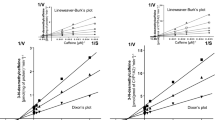Abstract
1. Human cytochrome P450 (CYP) isoenzymes expressed in a human cell line were used to elucidate their involvement in the metabolism of haloperidol (HAL).
2. It was found that CYP3A4 catalyzes the metabolism of HAL to HAL 1,2,3,6-tetrahydropyridine (HTP). HTP is further metabolized to HAL pyridinium (HP+) by both CYP3A4 and CYP2D6.
3. CYP3A4 and CYP2D6 are also responsible for the N-dealkylation of HAL. The N-dealkylation of reduced HAL (RH) was observed, which is catalyzed by CYP3A4. In addition, CYP3A4 also catalyzes the oxidation of RH back to HAL.
4. These results are discussed in terms of the metabolic interactions of HAL with other drugs and how this knowledge may be used to reduce the movement disorders induced by HAL.
Similar content being viewed by others
REFERENCES
Daniel, D. G., Randolph, C., Jaskiw, G., Handel, S., Williams, T., Abi-Dargham, A., Shoaf, S., Egan, M., Elkashef, A., Liboff, S., and Linnoila, M. (1994). Coadministration of fluvoxamine increases serum concentrations of haloperidol. J. Clin. Psychopharmacol. 14:340–343.
Fang, J., and Gorrod, J. W. (1991). Dehydration is the first step in the biotransformation of haloperidol to its pyridinium metabolite. Toxicol. Lett. 59:117–123.
Fang, J., and Gorrod, J. W. (1993). An HPLC system for the analysis of haloperidol and seven of its metabolites in microsomal preparations. J. Chromatogr. 614:267–273.
Fang, J., Zuo, D. M., and Yu, P. H. (1995). A comparison of a quaternary pyridinium metabolite of haloperidol (HP+) with the neurotoxin N-methyl-4-phenylpyridinium (MPP+) towards cultured dopaminergic neuroblastoma cells. Psychopharmacology 121:373–378.
Fang, J., Baker, G. B., and Coutts, R. T. (1996). Determination of 4-chlorophehyl-4-hydroxypiperidine, a metabolite of haloperidol, by gas chromatography with electron-capture detection. J. Chromatogr. Biomed. Appl. 682:283–288.
Forsman, A., and Larsson, M. (1978). Metabolism of haloperidol. Curr. Ther. Res. 24:567–568.
Goff, D. C., Midha, K. K., Brotman, A. W., Waites, M., and Baldessarini, R. J. (1991). Elevation of plasma concentrations of haloperidol after the addition of fluoxetine. Am. J. Psychiatry 148:790–792.
Gorrod, J. W., and Fang, J. (1993). On the metabolism of haloperidol. Xenobiotica 23:459–508.
LLerena, A., Alm, C., Dahl, M-.L., Ekqvist, B., and Bertilsson, L. (1992). Haloperidol disposition is dependent on debrisoquine hydroxylation phenotype. Ther. Drug Monit. 14:92–97.
Rollema, H., Skolnik, M., d'Engelbronner, J., Igarashi, K., Usuki, E., and Castagnoli, N., Jr. (1994). MPP+-like neurotoxicity of a pyridinium metabolite derived from haloperidol: In vivo microdialysis and in vitro mitochondrial studies. J. Pharmacol. Exp. Ther. 268:380–387.
Soudijn, W., Van Wijngaarden, I., and Allewijn, F. (1967). Distribution, excretion and metabolism of neuroleptics of the butyrophenone type. I. Excretion and metabolism of haloperidol and nine related butyrophenone-derivatives in the Wistar rat. Eur. J. Pharmacol. 1:47–57.
Subramanyam, B., Rollema, H., Woolf, T., and Castagnoli, N., Jr. (1990). Identification of a potentially neurotoxic pyridinium metabolite of haloperidol in rats. Biochem. Biophys. Res. Commun. 166:238–244.
Tate, J. L. (1989). Extrapyramidal symptoms in a patient taking haloperidol and fluoxetine. Am. J. Psychiatry 146:399–400.
Tyndale, R. F., Kalow, W., and Inaba, T. (1991). Oxidation of reduced haloperidol to haloperidol: Involvement of human P450IID6 (sparteine/debrisoquine monooxygenase). Br. J. Clin. Pharmacol. 31:655–660.
Young, D., Midha, K. K., Fossler, M. J., Hawes, E. M., Hubbard, J. W., McKay, G., and Korchinski, E. D. (1993). Effect of quinidine on the interconversion kinetics between haloperidol and reduced haloperidol in humans: Implications for the involvement of cytochrome P450IID6. Eur. J. Clin. Pharmacol. 44:433–438.
Author information
Authors and Affiliations
Rights and permissions
About this article
Cite this article
Fang, J., Baker, G.B., Silverstone, P.H. et al. Involvement of CYP3A4 and CYP2D6 in the Metabolism of Haloperidol. Cell Mol Neurobiol 17, 227–233 (1997). https://doi.org/10.1023/A:1026317929335
Issue Date:
DOI: https://doi.org/10.1023/A:1026317929335




